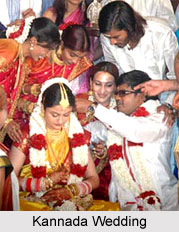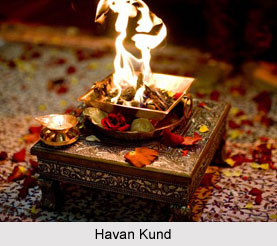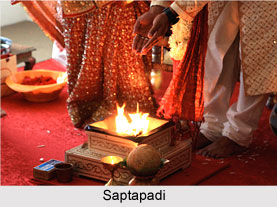 Kannada Weddings are a comparatively simple but pleasurable affair. It should be noted that there are different social communities in Karnataka and there are some dissimilarities in the wedding rituals followed by each of them. A general description of a typical wedding in Karnataka is given in this article.
Kannada Weddings are a comparatively simple but pleasurable affair. It should be noted that there are different social communities in Karnataka and there are some dissimilarities in the wedding rituals followed by each of them. A general description of a typical wedding in Karnataka is given in this article.
Kannada wedding costumes
In traditional Kannada weddings, the bride wears a navari or a nine-yard sari and green glass bangles. Moreover, she is adorned with fine gold jwellery of varied designs. The groom wears a silk dhoti and pitambar and a pheta that is a turban. In the right hand he holds a stick, which has been sanctified, in a holy place.
Among the various communities in Kannada, in the Baliga community wedding the wedding dress is completely different as the bride is dressed in white silk sari with contrasting colored border. The groom wears white silk dhoti edged with zari border and a Valli, which is an elongated cloth of the same material draped over the shoulders. He also wears a white shirt and adorns himself with ornamental turban of gold embellishment called pheta. A large tilak is marked his forehead.
The Kannada Coorg bride wears a customary brocade sari draped in distinctive Coorg style. A shroud covers the bride`s head. In Kannada weddings the groom`s family presents the bride five sarees. Each saree is meant for particular occasions during the wedding. During Dare Puja, the bride wears a grand Kancheevaram silk saree. A simple saree is worn during the haldi ritual. An elegant saree is selected for Puja and when the bride sits near the groom after Griha Pravesh.
 Pre-Wedding Rituals
Pre-Wedding Rituals
Some very fascinating pre-wedding customs are followed in Kannada wedding. Some of the wedding rituals done before the main wedding day in Karnataka are as follows:
Nischay Tamulam or Fixing of the Alliance: This is the solemnization ceremony after the matchmaking is over. After the parents of the forthcoming bride and the groom agree to the match, the alliance is solemnized with a plate of betel leaves and supari. The parents of the boy go to the bride`s home and present her a sari, blouse piece, coconut and fruits. The girl`s parents give the boy a dhoti, coconut and many fruits. A priest recites mantras. He also matches the horoscopes of the boy and the girl and thus fixes the date and time of the wedding.
Nandi: This ceremony is performed a few days prior to he wedding to ensure that the marriage takes place without any hitches/problems. There is a puja with coconut, aarti and a kalash or the copper pot. The first invitation card is offered to God.
Havan: On the day of the marriage, a havan is performed in the couple`s respective houses with strict recitation of mantras.
Departure of the Groom`s Party: After taking the blessings of the elders, gods, and goddesses in the house, the groom with his wedding baraat proceeds towards the wedding venue.
Greeting of the Barat: When the groom and his party reach the wedding venue, the sumangalis or married women approach the procession from the girl`s side and perform an arti. After the aarti is completed, these sumangalis lead the bridegroom inside the marriage hall.
Kaashi Yatre: This is a playful ritual with the groom pretending to get angry as nobody is searching for a bride for him and asks to go to Kashi on a pilgrimage. He carries a walking stick, an umbrella, a fan, a coconut, a small packet of rice and dal and a dhoti. During this ritual, his maternal uncle convinces him and brings him in front of the girl that he has chosen for him or offers his daughter`s hand for marriage.
Wedding Rituals
The Kannada wedding rituals are described below
Mandap Puja: On the day of marriage the first ritual that is performed is the Mandap Puja. This is to purify the mandap or the hall in which the marriage is to take place and make it appropriate for an event as sacred as a marriage. The bride`s father brings forth the groom to the mandap and is worshipped in a ceremony called the Var Puja. The bride`s parents honor him by washing his feet with pure, clan water and offer him a silk dhoti and pitambar, which he wears and sits for the rest of the marriage rituals.
Jaimala or the Garlanding Ceremony: In the Kannada wedding, the uncles of the bride escort her to the mandap. An interesting custom is followed, that is no one is supposed to see the bride`s face. Her sister shields her face with a lovely fan of peacock feathers. The bride and groom stand on the either side of a white cloth that separates them. For the chanting of the marriage mantras, known as the Mangalashtam, the bride and the groom take standing positions. The cloth is then removed, and the bride and groom garland each other amidst the large crowd of guests and chanting of mantras.
Dhare Herdu or the Giving Away of the Bride: In the rituals of Dhare Herdu, the bride`s father gives away the bride to the groom. He takes the groom`s hand and places it on the bride`s hand. The moment when the bride is given over to the groom, her father ceremonially pours water into the groom`s hands. This ritual is called dhara, signifying that she is now his. Corn or rice is then put into the havan five times, before the 7 pheras or the Saptapadi starts off.
Saptapadi: The groom`s angavastram and the bride`s pallav are tied together with a nuptial knot. The bride follows the groom`s footsteps seven times encircling the holy fire called the saptapadi. Five married women tie the mangalsutra or the holy thread while the bridegroom holds it around the neck of the bride. This ritual is one of the most important ones in Kannada wedding. The couple then bows before the elders, and visits the temple for blessings.
Post-Wedding Rituals

Post - wedding rituals of a traditional Kannada Wedding are very simple. They are described below -
Vidaai: Vidai ceremony signifies the tearful farewell of the bride from her paternal home for her husband`s house. The parents of the bride gift her an umbrella, vessels, cot and many more things by their own wish to help her set up her new home. In Kannada wedding, the bride is escorted by her brother who stays at the groom`s house for the night and comes back home the next day.
Graha Pravesh: Welcoming of the bride into her new home is called Griha Pravesh. The bride lightly kicks a kalash full of rice with her right foot that is kept at the threshold of the house. After this ceremony, the name change ceremony takes place. Here the groom decides a name for his bride and he inscribes with a ring on a plate filled with rice. On the second day the bride`s family comes to invite and take the newly wedded bride and the groom to their house. The couple stays at the bride`s place for a few days. Again after some days, the groom`s family goes over to his in-laws place to bring back the bride and the groom.
Kannada wedding feast
Kannada weddings are occasions for vegetarian delights. Some essential delicacies are four types of curry, sweet chutney, salt, pickle and two types of kosambari, which are salads, made of yogurt and cucumber or beetroot. Papad and Payasam are the indispensable preparations in the menu.
More on Marriage System in Indian States
More on Indian Wedding Accessories
More on Indian Religious Weddings
More on Types of Marriages
See also
 Kannada Weddings are a comparatively simple but pleasurable affair. It should be noted that there are different social communities in Karnataka and there are some dissimilarities in the wedding rituals followed by each of them. A general description of a typical wedding in Karnataka is given in this article.
Kannada Weddings are a comparatively simple but pleasurable affair. It should be noted that there are different social communities in Karnataka and there are some dissimilarities in the wedding rituals followed by each of them. A general description of a typical wedding in Karnataka is given in this article.
 Pre-Wedding Rituals
Pre-Wedding Rituals


















